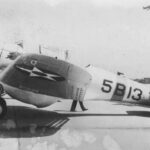BuNo 0614 aboard USS Yorktown
BuNo 0592 of the VB-5
U.S. Secretary of the Navy Frank Knox inspecting USS Enterprise
McClelland Barclay camo
McClelland Barclay experimental camouflage
McClelland Barclay experimental camouflage
BT-1 with McClelland Barclay camo
5-B-10 0637 of the of the Bombing Squadron Five (VB-5)
McClelland Barclay experimental camouflage
5-B-18 0614 assigned to the USS Yorktown
5-B-13 0609
6-B-12 BuNo 0599
The first all-metal aircraft to be accepted into service in the US Navy. Between 1938 and 1941, 53 machines of this type served as part of the VB-5 and VB-6 squadrons of the aircraft carriers USS Yorktown (CV-5) and USS Enterprise (CV-6). However, due to the difficulty of piloting at low speeds and the resulting high number of crashes, they were withdrawn from line service before the outbreak of the Pacific War and sent to training units. In operational service aboard ships, they were replaced by Douglas SBD Dauntless machines developed from them.
The Northrop BT-1 was designed in 1934 by Ed Heinemann at Northrop’s factory, in response to requirements submitted by the US Navy for an aircraft to replace the Martin BM-1 and Great Lakes BG-1. Five other designs participated in the resulting competition: Curtiss XSBC-3, Great Lakes XB2G-1, Grumman XSBF-1, Brewster XSBA-1 and Vought XSB2U-1.
The BT-1 design was based on the Douglas A-17 design intended to operate from land, and used the same P&W R-1535 engine, but introduced a partially retractable undercarriage. Standard armament for aircraft of the time consisted of a forward-firing 12.7mm machine gun with 230 rounds and a rear-firing 7.62mm machine gun on the dorsal of the aircraft, operated by a rear gunner. Compatible with the aircraft’s intended use, the bomb armament consisted of one 1,000-pound (454-kg) bomb under the fuselage and a 100-pound (45-kg) bomb under each wing. The compact form of the structure and a wingspan of 12.65 meters was adapted to the size of the hangars and elevators of US aircraft carriers. In order to avoid the effects of structural weaknesses in the wings during diving flight, the wings were not folded. However, the short wings affected flying characteristics, especially at low speeds.
A prototype of the machine was ordered on November 12, 1934, and on August 19, 1935 the XBT-1, numbered BuNo 9745, made its first flight. The machine was powered by a Pratt and Whitney R-1535-64 Twin Wasp Junior engine with 700 horsepower at takeoff. After the satisfactory results of the first tests on November 18, 1935, the Navy placed an order for the first batch of 54 machines. However, changes were made to the ordered design of the aircraft, numbered BuNo 0590 through 0643, in the form of the use of the Pratt & Whitney R-1535-94 engine, producing 825 horsepower, with a slightly smaller fuel capacity and additional equipment that increased the weight of the aircraft by 400 pounds to 4606 pounds (2901 kg). The ordered machines were produced at plants in California and were delivered to the Navy successively until October 1938, when the number of machines of this type in the US Navy’s inventory reached 52. Only 52 of the 54 machines ordered were delivered to the Navy, as one aircraft (BuNo 0627) was retained for testing of a new landing gear, while the other (BuNo 0627) was modified for the XBT-2 design, which later became the basis for the design of the primary US dive bomber of the early period of the Pacific War, the SBD-1 Dauntless.
The production version of the BT-1 featured good performance for the time, similar to the German Ju 87A Stuka. Only two units were formed from BT-1 aircraft: VB-5 operating from the aircraft carrier USS Yorktown (CV-5) and VB-6 in the USS Enterprise air group (CV-6), both based on the East Coast as part of Carrier Division 2. Manufactured in California, the aircraft first went to NAS San Diego, from where they were transported by sea to the East Coast to Naval Station Norfolk, Virginia. Both units began receiving the new aircraft in the spring of 1938. Two of the machines were used briefly by the VB-3 squadron from the aircraft carrier USS Saratoga, during its rearmament into SBD-3.
BT-ls were retained in first-line service until early in 1941, when they were replaced by SBD-2s and transferred to advanced training units before being surveyed.
Between 1941 and 1943, six of the machines also served in the Navy’s disposition units – VJ-3, VJ-5 and VJ-8.
According to available statistics, about half of the BTs built suffered accidents during just four years of operational service for machines of this type. Interestingly, the Dauntless, although derived from the BT, was such a refined design that it became the US Navy’s primary dive bomber in the early stages of World War II.
Source:
René J Francillon: McDonnell Douglas Aircraft since 1920 Volume I
Phil Listemann: Northrop BT-1











